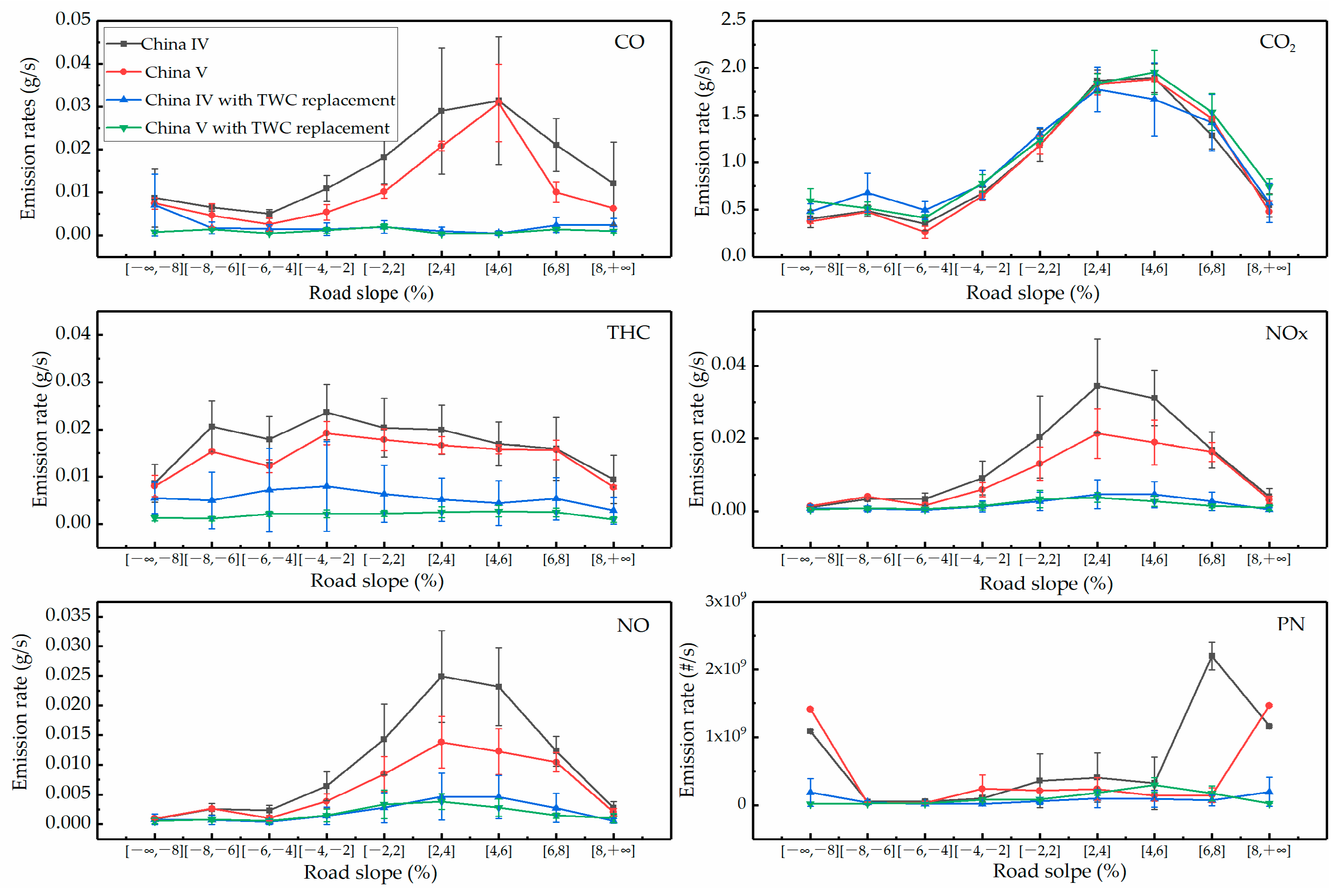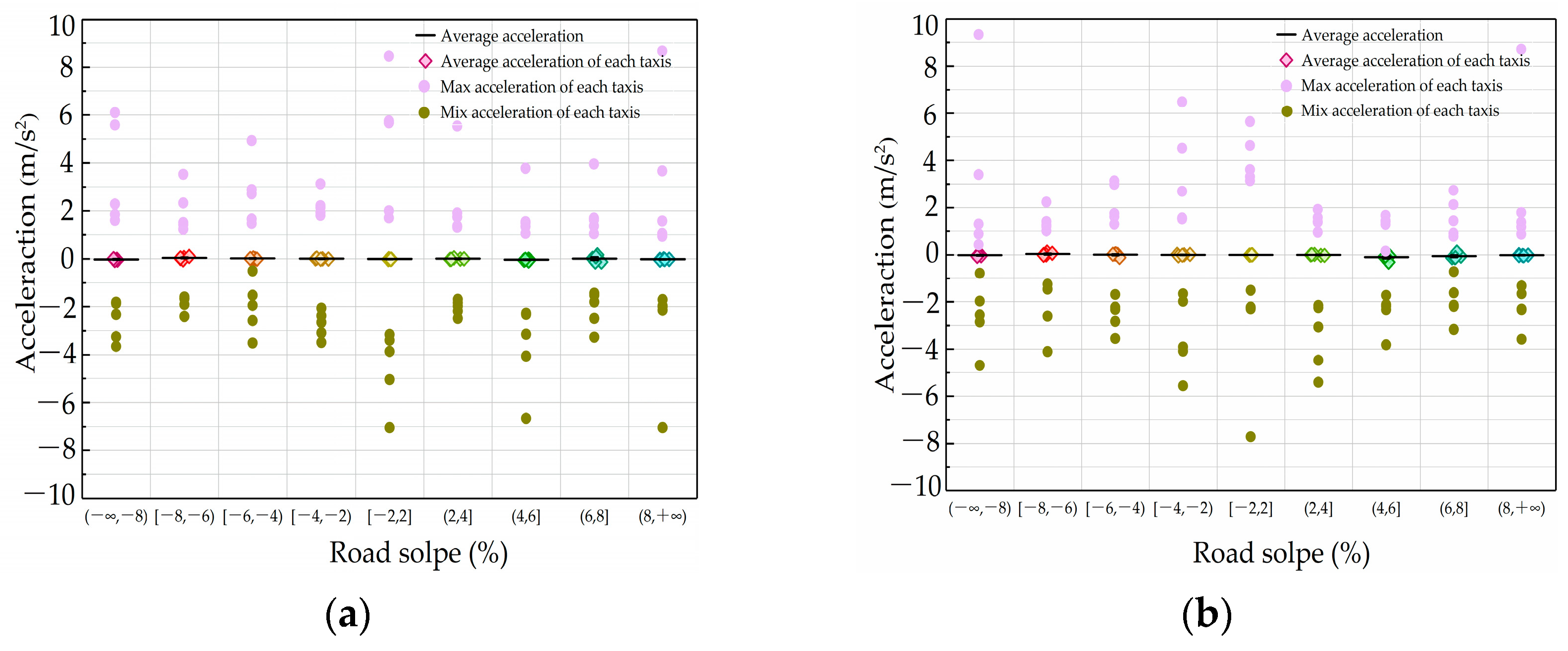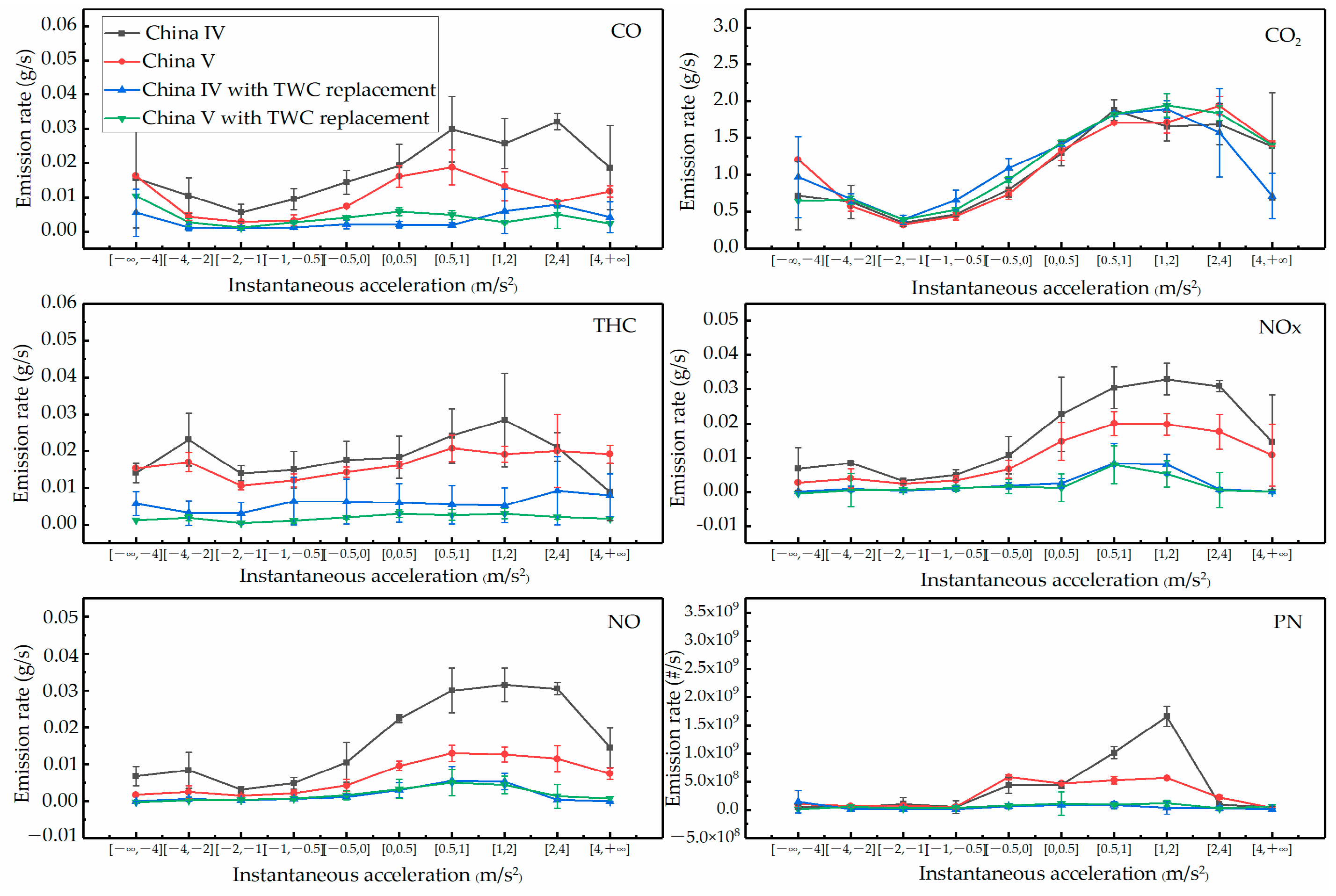Evaluating Real Driving Emissions of Compressed Natural Gas Taxis in Chongqing, China—A Typical Mountain Cities
Abstract
1. Introduction
2. Materials and Methods
2.1. Tested Vehicles
2.2. Test Route and Driving Cycles
2.3. Measurement System
2.4. TWC Replacement Test
2.5. Data Processing
3. Results
3.1. Distance-Specific Emission Factors
| Fuel Type | Emission Standard | Pollutants | ||||
|---|---|---|---|---|---|---|
| THC (g/km) | CO (g/km) | NOx (g/km) | PN (#/km × 1010) | |||
| This study | CNG | China IV | 2.02 ± 0.50 | 1.93 ± 0.60 | 1.80 ± 0.78 | 7.34 ± 3.87 |
| China V | 1.69 ± 0.20 | 1.47 ± 0.39 | 1.10 ± 0.29 | 13.7 ± 6.36 | ||
| China IV (TWC replacement) | 0.22 ± 0.05 | 0.28 ± 0.01 | 0.34 ± 0.20 | 2.32 ± 1.54 | ||
| China V (TWC replacement) | 0.25 ± 0.11 | 0.46 ± 0.03 | 0.43 ± 0.36 | 5.17 ± 1.38 | ||
| Zheng et al. [4] | Gasoline | China IV (without TWC) | 0.55 ± 0.07 | 0.09 ± 0.60 | 2.30 ± 0.6 | - |
| China IV (TWC replacement) | 0.01 ± 0.00 | 0.90 ± 0.80 | 0.03 ± 0.02 | - | ||
| Huang et al. [28] | Gasoline | Euro IV | 0.047 | 1.07 | 0.17 | 15,700 |
| Zhang et al. [30] | Gasoline | Euro IV | 0.02 ± 0.01 | 0.40± 0.21 | 0.05 ± 0.03 | - |
| Kontses et al. [34] | CNG | Euro IVb | - | - | - | 14.00 |
| Yao et al. [35] | CNG | Euro III | 0.61 ± 0.39 | 0.60 ± 0.50 | 1.19 ± 1.27 | - |
| Xie et al. [36] | CNG | Euro III | 1.19 | 4.60 | 1.00 | - |
| Emission limits 1 | CNG | China IV | 0.20 | 2.30 | 0.15 | - |
| China V | 0.10 | 1.00 | 0.60 | 60 | ||
3.2. Impact of Speed on Emission
3.3. Impact of Road Slope on Emission
3.4. Impact of Instantaneous Acceleration on Emission
3.5. Impact of Natural Gas Consumption
3.6. Emission Rates by Operating Mode
4. Discussion
5. Conclusions
Supplementary Materials
Author Contributions
Funding
Institutional Review Board Statement
Informed Consent Statement
Data Availability Statement
Conflicts of Interest
Abbreviations
| CNG | Compressed natural gas | TWC | Three-way catalyst |
| PEMS | Portable emissions measurement system | VSP | Vehicle specific power |
| OBD | On-board diagnostic system | UFs | Urban freeways |
| PRs | Primary roads | SRs | Secondary roads |
| ASM | Acceleration simulation mode | GPS | Global positioning system |
| I/M | Inspection/Maintenance | NEDC | New European Driving Cycle |
References
- Liu, G.; Sun, S.D.; Zou, C.; Wang, B.; Wu, L.; Mao, H.J. Air pollutant emissions from on-road vehicles and their control in Inner Mongolia, China. Energy 2022, 179, 660–668. [Google Scholar] [CrossRef]
- Deng, F.Y.; Lv, Z.F.; Qi, L.J.; Wang, X.T.; Shi, M.S.; Liu, H. A big data approach to improving the vehicle emission inventory in China. Nat. Commun. 2020, 24, 2–13. [Google Scholar] [CrossRef] [PubMed]
- Anenberg, S.C.; Miller, J.; Minjares, R.; Du, L.; Henze, D.K.; Lacey, F.; Malley, C.S.; Emberson, L.; Franco, V.; Klimont, Z.; et al. Impacts and mitigation of excess diesel-related NOx emissions in 11 major vehicle markets. Nature 2017, 545, 467–471. [Google Scholar] [CrossRef] [PubMed]
- Zheng, X.; Wu, Y.; Zhang, S.J.; He, L.Q.; Hao, J.M. Evaluating real-world emissions of light-duty gasoline vehicles with deactivated three-way catalyst converters. Atmos. Pollut. Res. 2018, 9, 126–132. [Google Scholar] [CrossRef]
- Zhang, S.J.; Wu, Y.; Wu, X.M.; Li, M.L.; Ge, Y.S.; Liang, B.; Xu, Y.Y.; Zhou, Y.; Liu, H.; Fu, L.X.; et al. Historic and future trends of vehicle emissions in Beijing, 1998–2020: A policy assessment for the most stringent vehicle emission control program in China. Atmos. Environ. 2014, 89, 216–229. [Google Scholar] [CrossRef]
- Huang, C.Y.; Shan, W.P.; Lian, Z.H.; Zhang, Y.; He, H. Recent advances in three-way catalysts of natural gas vehicles. Catal. Sci. Technol. 2020, 10, 6407–6419. [Google Scholar] [CrossRef]
- He, L.Q.; Hu, J.N.; Yang, L.; Li, Z.H.; Zheng, X.; Xie, S.X.; Zu, L.; Chen, J.H.; Li, Y.; Wu, Y. Real-world gaseous emissions of high-mileage taxi fleets in China. Sci. Total. Environ. 2019, 659, 267–274. [Google Scholar] [CrossRef] [PubMed]
- Qiao, Q.Y.; Zhao, F.Q.; Liu, Z.W.; He, X.; Hao, H. Life cycle greenhouse gas emissions of electric vehicles in China: Combining the vehicle cycle and fuel cycle. Energy 2019, 177, 222–233. [Google Scholar] [CrossRef]
- Xu, T.T.; Hu, X.R.; Long, Y.; Liu, L.; Tian, X.; Chen, Z.X. Planning of the fast charging facilities for electric vehicles in mountainous cities. In Proceedings of the 5th International Conference on Information Technologies and Electrical Engineering, Changsha, China, 4–6 November 2022; pp. 462–468. [Google Scholar]
- Ajanovic, A.; Haas, R. Dissemination of electric vehicles in urban areas: Major factors for success. Energy 2016, 115, 1451–1458. [Google Scholar] [CrossRef]
- Matam, S.K.; Otal, E.H.; Aguirre, M.H.; Winkler, A.; Ulrich, A.; Rentsch, D.; Weidenkaff, A.; Ferri, D. Thermal and chemical aging of model three-way catalyst Pd/Al2O3 and its impact on the conversion of CNG vehicle exhaust. Catal. Today 2012, 184, 237–244. [Google Scholar] [CrossRef]
- Winkler, A.; Dimopoulos, P.; Hauert, R.; Bach, C.; Aguirre, M. Catalytic activity and aging phenomena of three-way catalysts in a compressed natural gas/gasoline powdered passenger car. Appl. Catal. B Environ. 2008, 84, 162–169. [Google Scholar] [CrossRef]
- Zou, H.B.; Yang, Z.Q.; Sun, X.; Feng, Y. Application of catalyst diagnostic method based on bear oxygen sensor signal. Veh. Eng. 2015, 4, 89–92. [Google Scholar]
- Gómez, A.; Fernández-Yáñez, P.; Soriano, J.; Sánchez-Rodríguez, L.; Mata, C.; García-Contreras, R.; Armas, O.; Cárdenas, D.M. Comparison of real driving emissions from Euro Ⅵ buses with diesel and conpressed natural gas fuels. Fuel 2021, 289, 119836–119848. [Google Scholar] [CrossRef]
- Wu, Y.; Zhang, S.J.; Hao, J.M.; Liu, H.; Wu, X.M.; Hu, J.N.; Walsh, M.P.; Wallington, T.J.; Zhang, K.M.; Stevanovic, S. On-road vehicle meission and their control in China: A review and outlook. Sci. Total Environ. 2017, 574, 332–349. [Google Scholar] [CrossRef] [PubMed]
- Lv, L.; Ge, Y.S.; Ji, Z.; Tan, J.; Wang, X.; Hao, L.J.; Wang, Z.W.; Zhang, M.Z.; Wang, C.J.; Liu, H.D. Regulated emission characteristics of in-use LNG and diesel semi-trailer towing vehicles under real driving conditions using PEMS. J. Environ. Sci. 2020, 88, 155–164. [Google Scholar] [CrossRef] [PubMed]
- Bergman, M.; Kirchner, U.; Vogt, R.; Benter, T. On-road and laboratory investigation of low-level PM emissions of a modern diesel particulate filter equipped diesel passenger car. Atmos. Environ. 2009, 43, 1908–1916. [Google Scholar] [CrossRef]
- Lv, Z.; Yang, L.; Wu, L.; Peng, J.; Zhang, Q.; Sun, M.; Mao, H.; Min, J. Comprehensive analysis of the pollutant characteristics of gasoline vehicle emissions under different engine, fuel, and test cycles. Energies 2022, 15, 622–642. [Google Scholar] [CrossRef]
- Mamakos, A.; Bonnel, P.; Perujo, A.; Carriero, M. Assessment of portable emission measurement systems (PEMS) for heavy-duty diesel engines with respect to particulate matter. J. Aerosol. Sci. 2013, 57, 54–70. [Google Scholar] [CrossRef]
- Sun, D.; Zhang, Y.; Zhang, Y. Modeling carbon emission from urban traffic system using mobile monitoring. Sci. Total Environ. 2017, 599–600, 944–951. [Google Scholar] [CrossRef]
- Degraeuwe, B.; Weiss, M. Does the new European driving cycle (NEDC) really fail to capture the NOx emissions of diesel cars in Europe. Environ. Pollut. 2017, 222, 234–241. [Google Scholar] [CrossRef]
- Franco, V.; Kousoulidou, M.; Muntean, M.; Ntziachristos, L.; Hausberger, S.; Dilara, P. Road vehicle emission factors development: A review. Atmos. Environ. 2013, 70, 84–97. [Google Scholar] [CrossRef]
- Lv, Z.Y.; Wu, L.; Yang, Z.W.; Yang, L.; Fang, T.G.; Mao, H.J. Comparison on real-world driving emission characteristics of CNG, LNG and hybrid-CNG buses. Energy 2023, 262, 125571–125581. [Google Scholar] [CrossRef]
- Zheng, F.; Zhang, H.F.; Yin, H.; Fu, M.L.; Jiang, H.; Li, J.Q.; Ding, Y. Evalustion of real-world emissions of China Ⅴ heavy-duty vehhicles fueled by diesel, CNG and LNG on various road types. Chemosphere 2022, 303, 135137–135144. [Google Scholar] [CrossRef] [PubMed]
- Zhang, L.; Lin, J.; Qiu, R. Characterizing the toxic gaseous emissions of gasoline and diesel vehicles based on a real-world on-road investigation. J. Clean. Prod. 2022, 286, 124957–124973. [Google Scholar] [CrossRef]
- Gallus, J.; Kirchner, U.; Vogt, R.; Börensen, C.; Benter, T. On-road particle number measurements using a portable emission measurement systems (PEMS). Atmos. Environ. 2016, 124, 37–45. [Google Scholar] [CrossRef]
- Zhang, Y.; Lou, D.; Tan, P.; Hu, Z. Experimental study on the particulate matter and nitrogenous compounds from diesel engine retrofitted with DOC+CDPF+SCR. Atmos. Environ. 2018, 177, 45–53. [Google Scholar] [CrossRef]
- Huang, C.; Lou, D.M.; Hu, Z.Y.; Feng, Q.; Chen, Y.R.; Chen, C.H.; Tan, P.Q.; Yao, D. A PEMS study of the emissions of gaseous pollutants and ultrafine particles from gasoline- and diesel-fueled vehicles. Atmos. Environ. 2013, 77, 703–710. [Google Scholar] [CrossRef]
- Wu, X.; Zhang, S.; Wu, Y.; Li, Z.; Zhou, Y.; Fu, L.; Hao, J.M. Real-world emissions and fuel consumption of diesel buses and trucks in Macao: From on-road measurement to policy implications. Atmos. Environ. 2015, 120, 393–403. [Google Scholar] [CrossRef]
- Zhang, S.J.; Wu, Y.; Liu, H.; Huang, R.K.; Un, P.K.; Zhou, Y.; Fu, L.X.; Hao, J.M. Real-world fuel consumption and CO2 (carbon dioxide) emissions by driving conditions for light-duty passenger vehicles in China. Energy 2014, 69, 247–257. [Google Scholar] [CrossRef]
- Jiménez-Palacios, J. Understanding and Quantifying Motor Vehicle Emissions with Vehicle Specific Power and TILDAS Remote Sensing; Massachusetts Institute of Technology: Cambridge, MA, USA, 1999. [Google Scholar]
- Ghaffarpasand, O.; Talaie, M.R.; Ahmadikia, H.; Talaiekhozani, A.; Shalamzari, M.D.; Majidi, S. On-road performance and emission characteristics of CNG-gasoline bi-fuel taxis/private cars at the roadside environment. Atmos. Pollut. Res. 2020, 11, 1743–1753. [Google Scholar] [CrossRef]
- Wang, A.; Xu, J.S.; Zhang, M.Q.; Zhai, Z.Q.; Song, G.H.; Hatzpoulou, M. Emissions and fuel consumption of a hybrid electric vehicle in real-world metropolitan traffic conditions. Appl. Energy 2022, 306, 118077–118089. [Google Scholar] [CrossRef]
- Kontses, A.; Triantafyllopoulos, G.; Ntziachristos, L.; Samaras, Z. Particle number (PN) emisssions from gasoline, diesel, LPG, CNG and hybrid-electric light-duty vehicles under real-world driving conditions. Atmos. Environ. 2020, 222, 117126–117139. [Google Scholar] [CrossRef]
- Yao, Z.L.; Cao, X.Y.; Shen, X.B.; Zhang, Y.Z.; Wang, X.T.; He, K.B. On-road emission characteristics of CNG-fueled bi-fuel taxis. Atmos. Environ. 2014, 94, 198–204. [Google Scholar] [CrossRef]
- Xie, S.; Hu, J.; Bao, X.; Li, Z.; Wang, H.; Zhang, K. Real-world emission characteristics of natural gas-gasoline bi-fuel vehicles. Acta Sci. Circumst. 2011, 31, 2347–2353. [Google Scholar]
- Guo, X.; Wang, G.L.; Zhang, S.P.; Zhang, W. Correlation analysis of light passenger vehicles energy consumption and driving charateristics. Adv. Intell. Syst. Comput. 2019, 929, 1093–1102. [Google Scholar]
- Christopher Frey, H.; Zhang, K.; Rouphail, N. Fuel use and emissions comparisons for alternative routes, time of day, road grade, and vehicles based on in-use measurements. Environ. Sci. Technol. 2008, 42, 2483–2489. [Google Scholar] [CrossRef]
- The Transportation Research Board’s Highway Capacity Manual; Transportation Research Board: Washington, DC, USA, 2000.
- Mogro, A.; Hauertas, J. Assessment of the effect of using air conditioning on the vehicle’s real fuel consumption. Int. J. Interact. Des. Manuf. 2021, 15, 271–285. [Google Scholar] [CrossRef]
- Liu, B.; Chen, K.; Lu, S. Flow field analysis and structure optimization of exhaust manifold catalytic converter. Auto. Eng. 2007, 12, 1066–1069. [Google Scholar]





Disclaimer/Publisher’s Note: The statements, opinions and data contained in all publications are solely those of the individual author(s) and contributor(s) and not of MDPI and/or the editor(s). MDPI and/or the editor(s) disclaim responsibility for any injury to people or property resulting from any ideas, methods, instructions or products referred to in the content. |
© 2024 by the authors. Licensee MDPI, Basel, Switzerland. This article is an open access article distributed under the terms and conditions of the Creative Commons Attribution (CC BY) license (https://creativecommons.org/licenses/by/4.0/).
Share and Cite
Hu, W.; Duan, L.; Tang, M.; Yuan, R.; Lv, G.; Lv, P.; Li, Z.; Li, L.; Xu, H.; Ding, J.; et al. Evaluating Real Driving Emissions of Compressed Natural Gas Taxis in Chongqing, China—A Typical Mountain Cities. Atmosphere 2024, 15, 715. https://doi.org/10.3390/atmos15060715
Hu W, Duan L, Tang M, Yuan R, Lv G, Lv P, Li Z, Li L, Xu H, Ding J, et al. Evaluating Real Driving Emissions of Compressed Natural Gas Taxis in Chongqing, China—A Typical Mountain Cities. Atmosphere. 2024; 15(6):715. https://doi.org/10.3390/atmos15060715
Chicago/Turabian StyleHu, Wei, Linfeng Duan, Min Tang, Rui Yuan, Gaiyan Lv, Pingjiang Lv, Zhenliang Li, Ling Li, Hualong Xu, Jiajia Ding, and et al. 2024. "Evaluating Real Driving Emissions of Compressed Natural Gas Taxis in Chongqing, China—A Typical Mountain Cities" Atmosphere 15, no. 6: 715. https://doi.org/10.3390/atmos15060715
APA StyleHu, W., Duan, L., Tang, M., Yuan, R., Lv, G., Lv, P., Li, Z., Li, L., Xu, H., Ding, J., & Zhang, D. (2024). Evaluating Real Driving Emissions of Compressed Natural Gas Taxis in Chongqing, China—A Typical Mountain Cities. Atmosphere, 15(6), 715. https://doi.org/10.3390/atmos15060715




